|
Tuesday, November 11, Friendship
Manor held a Veterans Day service to honor the veterans who live
there for serving our country.
There were six veterans present who were honored and given gift bags
as tokens of appreciation.
The veterans who were recognized for their service included:
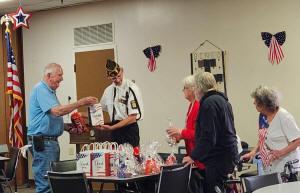
Donald Wibben, who served in the
U.S. Air Force from 1956 to 1962.
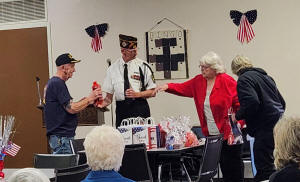
Kenneth Delaney, who served as an
E2 second class in the U.S. Navy from 1960-1964.

Jeff Singleton, who served as an E3
seaman in the U.S. Navy from 1962 to 1965.
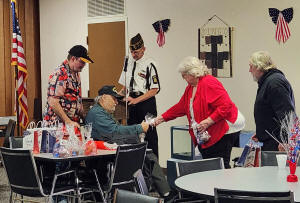
Randel Wyland, who served as an E5
hall technician in the U.S. Navy from 1974 to 1979. Joining him was
his caregiver Drew Cook, who served as an E4 in the Army National
Guard from 1992 to 2008.


James Grigg, who served in as an E5
Aviation coordinator in the U.S. Navy from 1984 to 1991.
Veterans from Friendship Manor who were not present were James
Saulaberry and Robert Thomas. Both men served in the U.S. Navy.
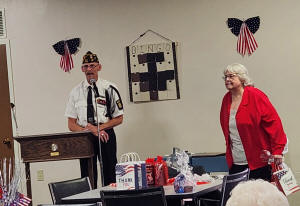
The guest speaker was Chris Glick,
who served in the United States Navy from 1985 to 2005. Glick served
during Desert Storm and later worked for a weapons warfare center in
Southwest Indiana. He then changed jobs and went to the U.S. Seabees
for a construction battalion, was deployed in 2003 during the
Iraq/Afghanistan War and retired in 2005.
Glick started by talking about the symbolism of the colors of the
American Flag. He said the red stands for valor and courage, the
white for purity, innocence, justice and equality and the blue for
vigilance and justice.
Each of the thirteen stripes of the U.S. flag has a significant
meaning, too. For instance, the first one represents life, the
second one represents eternal life. The third one is in honor
remembrance of the veteran leaving the ranks who gave a portion of
his or her life in service of our country to attain peace throughout
the world.
The fourth stripe symbolizes our weaker nature as American citizens
trusting in God. It is him who we turn to in times of peace as well
as times of war for his divine guidance. The fifth one represents a
tribute to our country. Glick said, in the words of Stephen Decatur,
“Our country, in dealing with other countries, may she always be
right, but it is still our country, right or wrong.”
The sixth stripe is for where our hearts lie. Since it is with our
heart we pledge allegiance to the U.S. flag, Glick had everyone who
was able to stand up and say the pledge of allegiance.

[to top of second column] |

The seventh stripe is a tribute
to our armed forces which protect our country. The eighth stripe
is a tribute to one who entered into the valley of the shadow of
death. Glick said it also honors our mother for whom it flies on
Mother’s Day.
The ninth stripe is a tribute womanhood because their love,
loyalty and devotion molded the character of the men and women
who made this country great. The tenth is a tribute to fathers
who have given sons and daughters to defend our country.
The eleventh stripe represents the lower portion of the seal of
King David and King Solomon and glorifies the God of Abraham,
Isaac and Jacob. The twelfth stripe represents an emblem of
eternity and glorifies God the Father, the Son and the Holy
Ghost. Finally, the thirteen one, when the flag is completely
folded, the stars are uppermost reminding us of our nation’s
motto, “In God we trust.”
Glick also spoke about so many veterans experiencing Post
Traumatic Stress Disorder. He said PTSD keeps people from
discussing what they have been through.
Two of the armed forces celebrated 250 years recently. Glick
said October 13 was the U.S. Navy’s birthday and November 10 was
the U.S. Marine Corps’ birthday.
For the second portion of his address, Glick talked about
something that is hard on many men and women, which are the
aspects Post Traumatic Stress Disorder. He said many people will
not discuss what they have been through because PTSD brings up
too many hard memories and brings on depression and anxiety.
PTSD puts some in a state of rage.
In the U.S., Glick said we do not have enough facilities to
accommodate the men and women in the Armed forces who have PTSD.
When the VA in Danville was full years ago, Glick said they
would send veterans to the mental health facility he worked at
in Southern Illinois. He remembers one man who had extreme PTSD.
After arriving there, Glick said the man would not talk to
anyone. The man stayed in his room and the only time he came out
was to eat. When the man found out there were other veterans on
his floor who served during the same time he did, Glick said he
finally started opening up to us. He let Glick and others know
what was going on and what went wrong.
Though the man was able to get help, Glick said it was hard to
convince some of the counselors, social workers, psychologists
and psychiatrists he needed to be evaluated. These professionals
would tell Glick and other staff they didn’t know what they were
talking about since they didn’t have letters or degrees behind
their names.
It took three attempts for the counselors and the others to
finally listen to what Glick and others said. The man would only
talk if Glick and other veterans came in with him to the
evaluation. Once the professionals listened to what this man had
to say, he got the help he needed. Glick said he was able to be
discharged from the facility within two and half weeks.
There are other instances Glick recalls where it was hard to get
veterans evaluated until three veterans came in to talk to them.
In these cases, Glick said these men would be discharged and set
up in a different program within a couple of weeks. The
professionals finally listened to veterans telling them what
happens to other veterans.

The VA facilities do not have
enough room for the men and women who have mental health issues, so
they are being left behind. Glick said 21 veterans commit suicide
every day and one a day is too many. He would like to see veterans
have more options for mental health care.
Glick encouraged everyone there to contact state and federal
senators and congressmen about these issues until something is done
in each and every state.
Anna Clapp, who helped organize the
event, closed by thanking those who had a spouse or loved one in the
military for being there for them. Clapp then thanked committee
members Rosie Awe, Ginny Broughton, Bruce King, Richard Reiners and
Gwen Wilson for helping her plan the event. She also thanked the
veterans for their service.
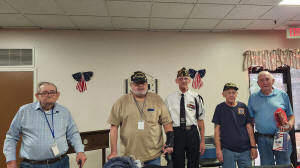
Once the service had ended, all the
veterans in attendance posed for a photo.
[Angela Reiners]
|